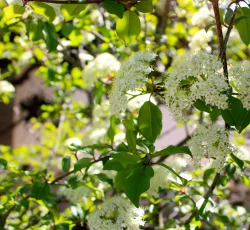
Beautyberry
Callicarpa americana
All parts of this bold shrub are fragrant. It particularly deserves its name for the profusion of amethyst purple berries borne on its long branches.
EXPLORE THIS PLANT
All parts of this bold shrub are fragrant. It particularly deserves its name for the profusion of amethyst purple berries borne on its long branches.
EXPLORE THIS PLANT
Bee Balm is a tall summer-blooming perennial with brilliant red flowers subtended by a whorl of showy, red-tinged, leafy bracts. The aromatic leaves can be used for tea, but are susceptible to mildew, so this plant needs good air circulation. A member of the mint family, bee balm spreads readily by rhizomes and self-seeding to form large colonies, so be prepared to divide it every few years.
EXPLORE THIS PLANT
A cottage garden favorite, black-eyed susan features masses of ferociously yellow flowers that attract butterflies. They are incredibly hardy and tolerate a wide variety of conditions, making them ideal for naturalizing.
EXPLORE THIS PLANT
Blackberry lilies are named for their glossy black seeds which look nearly identical to an actual blackberry. They have beautiful orange flowers with darker spots on long graceful stems above strappy green foliage.
EXPLORE THIS PLANT
These large spring blooming shrubs with edible berries do best in natural areas where they can achieve their full size.
EXPLORE THIS PLANT
This unique plant features bright blue-purple flowers on tall green stalks followed by interesting black seedpods. It forms a deep taproot and does not transplant well, so be certain of its location before planting.
EXPLORE THIS PLANT
Blue Flag is a petite double tulip with flouncy purple petals. Its short stature makes it ideally suited for the front of the border.
EXPLORE THIS PLANT
Blue sky vine is a large, twining vine that boasts beautiful pale blue flowers. It is a rapid grower and becomes quite large over the course of a season.
EXPLORE THIS PLANT
Boxwood are the quintessential southern garden hedge plant. They are popular for use in knot gardens, parterres, edging, and as topiaries. While the historic English boxwood (Buxus suffruiticosa) are especially susceptible to a devastating and widespread blight caused by the fungus Cylindrocladium buxicola, there are new varieties that have been bred to offer various levels of resistance. Several varieties of boxwood grow in the Mount Vernon gardens including: Buxus sempervirens (American), Buxus microphylla var. japonica 'Green Beauty', and 'Morris Dwarf.'
EXPLORE THIS PLANT
This elegant annual forms an attractive seedhead after blooming and is ideal for the middle of the border in the spring garden. It self-sows reliably, but does not transplant well.
EXPLORE THIS PLANT